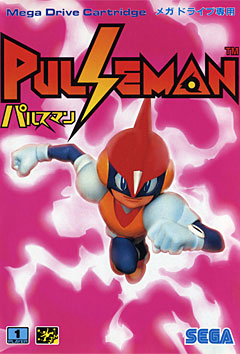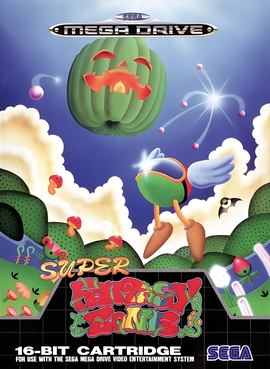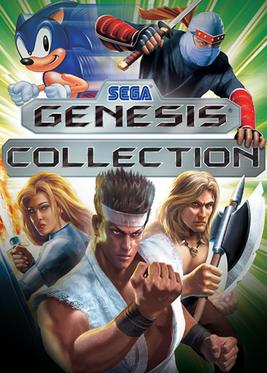
The Master System is an 8-bit third-generation home video game console manufactured and developed by Sega. It was originally a remodeled export version of the Sega Mark III, the third iteration of the SG-1000 series of consoles, which was released in Japan in 1985 with graphical capabilities improved over its predecessors. The Master System launched in North America in 1986, followed by Europe in 1987, and then in Brazil and Korea in 1989. A Japanese version of the Master System was also launched in 1987, which features a few enhancements over the export models : a built-in FM audio chip, a rapid-fire switch, and a dedicated port for the 3D glasses. The Master System II, a cheaper model, was released in 1990 in North America, Australasia and Europe.

Columns is a match-three puzzle video game released by Jay Geertsen in 1989. Designed for the 68000-based HP 9000 running HP-UX, it was ported to Mac and DOS before being released commercially by Sega who ported it to arcades and then to several Sega consoles. The game was subsequently ported to other home computer platforms, including the Atari ST.

Shinobi (忍) is a side-scrolling hack and slash video game produced by Sega, originally released for arcades on the Sega System 16 board in 1987. The player controls ninja Joe Musashi, to stop the Zeed terrorist organization from kidnapping students of his clan.

In the history of video games, the fourth generation of video game consoles, more commonly referred to as the 16-bit era, began on October 30, 1987, with the Japanese release of NEC Home Electronics' PC Engine. Though NEC released the first console of this era, sales were mostly dominated by the rivalry between Sega and Nintendo across most markets: the Sega Mega Drive and the Super Nintendo. Cartridge-based handheld game consoles became prominent during this time, such as the Nintendo Game Boy, Atari Lynx, Sega Game Gear and TurboExpress.

Altered Beast is a 1988 beat 'em up arcade video game developed and published by Sega. The game is set in Ancient Greece and follows a player character chosen by Zeus to rescue his daughter Athena from the demonic ruler of the underworld, Neff. Through the use of power-ups, the player character can assume the form of different magical beasts. It was ported to several home video game consoles and home computers. It was the pack-in game for the Mega Drive when that system launched in 1988.

Dr. Robotnik's Mean Bean Machine is a falling block puzzle game developed by Compile and published by Sega. It was released for the Sega Genesis / Mega Drive in North America and Europe in November 1993, and ported to the Game Gear in 1993 and Master System in 1994.

Ecco the Dolphin is an action-adventure game developed by Ed Annunziata and Novotrade International and published by Sega for the Mega Drive/Genesis in 1992. Versions for the Sega CD, Master System and Game Gear were released the following year. It is the first installment in the Ecco the Dolphin video game franchise. The player character is a bottlenose dolphin who travels through time to combat hostile extraterrestrials in Earth's oceans and on an alien spacecraft.

Earthworm Jim 2 is a 1995 run and gun platform video game and the sequel to Earthworm Jim, and the second and final game in the Earthworm Jim series developed by original creators Doug TenNapel, David Perry and Shiny Entertainment. It was released in late 1995 and early 1996 depending on region and video game console, initially being released for the Sega Genesis and Super Nintendo Entertainment System, before being ported to other platforms.

Gunstar Heroes is a run and gun video game developed by Treasure and published by Sega. It was Treasure's debut game, originally released for the Sega Genesis in 1993. The game's premise is centered around a pair of characters, the Gunstars, in their efforts to stop an evil empire from recovering four powerful gems. The characters can fire guns and perform a series of acrobatic maneuvers to fight enemies across each stage. There are four weapons in the game which can be combined with one another to create different shot types.

The Revenge of Shinobi, released in Japan as The Super Shinobi, is a hack-and-slash action video game developed and published by Sega in 1989. It was the first Shinobi game developed for the Sega Genesis, and was later released on the coin-operated version of that console, the Mega-Tech.
The Virtual Console is a defunct line of downloadable video games for Nintendo's Wii and Wii U home video game consoles and the Nintendo 3DS family of systems.

The Sega Genesis, also known as the Mega Drive outside North America, is a 16-bit fourth generation home video game console developed and sold by Sega. It was Sega's third console and the successor to the Master System. Sega released it in 1988 in Japan as the Mega Drive, and in 1989 in North America as the Genesis. In 1990, it was distributed as the Mega Drive by Virgin Mastertronic in Europe, Ozisoft in Australasia, and Tectoy in Brazil. In South Korea, it was distributed by Samsung Electronics as the Super Gam*Boy and later the Super Aladdin Boy.

Pulseman is a 1994 Japanese platform game developed by Game Freak and published by Sega for the Sega Mega Drive. It was released in North America for the Sega Channel in 1995. It was re-released on the Virtual Console for the Wii in 2007 and 2009, and the Nintendo Switch Online + Expansion Pack in 2023.

Shinobi is a series of hack-and-slash games created by Sega. The ninja (shinobi) Joe Musashi is the protagonist of the original series of games. The first Shinobi was released in 1987 as an arcade video game. Along with Alex Kidd and Sonic the Hedgehog, Joe Musashi has long been one of Sega's flagship characters, acting as a mascot for a short time in the late 1980s when ninjas were popular in mainstream media. The series' games are a showcase of Sega's technical accomplishment, noted for their high quality of graphics, gameplay and music, as well as their high level of difficulty. The Shinobi franchise sold more than 4.60 million copies.

Shadow Dancer: The Secret of Shinobi, also known simply as Shadow Dancer, is a side-scrolling action game developed and published by Sega for the Sega Genesis in 1990. It is the second game in the Shinobi series released for the Mega Drive, following The Revenge of Shinobi. However, it is not a continuation of the previous game, but rather a loose adaptation of the 1989 arcade game Shadow Dancer. Like in the original arcade game, the player controls a ninja followed by a canine companion. The Secret of Shinobi was well received by critics.

Super Fantasy Zone is a scrolling shooter, part of the Fantasy Zone series. It was released for the Sega Mega Drive in Japan and Europe. Players control the character Opa-Opa on his quest to defeat Dark Menon, and the game plays similarly to previous Fantasy Zone entries. The game plays similarly to Defender, where the screen scrolls in the direction that Opa-Opa is going. The player shoots at enemies to defeat them, collecting gold coins that are used to purchase temporary upgrades that improve Opa-Opa's offensive capabilities and speed, among other things.

Sega Genesis Collection is a compilation of video games developed by Digital Eclipse and published by Sega for PlayStation 2 and PlayStation Portable. The collection includes twenty-eight Sega Genesis games from a variety of genres, as well as unlockable classic Sega arcade games, with different sets of arcade games for the PlayStation 2 and PlayStation Portable versions. A sequel was released in 2009 called Sonic's Ultimate Genesis Collection for PlayStation 3 and Xbox 360.

Sonic's Ultimate Genesis Collection is a compilation of video games developed by Backbone Entertainment and published by Sega for PlayStation 3 and Xbox 360. The compilation features 48 Sega games which were previously released for the Sega Genesis, arcades and the Master System. It is the sequel to the Sega Genesis Collection released previously for the PlayStation 2 and PlayStation Portable, but contains 16 more games.
Online console gaming involves connecting a console to a network over the Internet for services. Through this connection, it provides users the ability to play games with other users online, in addition to other online services.
















